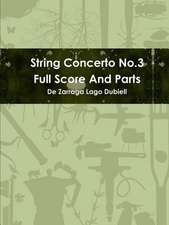Sculpting Simulacra in Medieval Germany, 1250-1380
Autor Assaf Pinkusen Limba Engleză Hardback – 17 sep 2014
| Toate formatele și edițiile | Preț | Express |
|---|---|---|
| Paperback (1) | 345.01 lei 6-8 săpt. | |
| Taylor & Francis – 25 apr 2018 | 345.01 lei 6-8 săpt. | |
| Hardback (1) | 1003.61 lei 6-8 săpt. | |
| Taylor & Francis – 17 sep 2014 | 1003.61 lei 6-8 săpt. |
Preț: 1003.61 lei
Preț vechi: 1223.92 lei
-18% Nou
Puncte Express: 1505
Preț estimativ în valută:
192.04€ • 201.04$ • 158.90£
192.04€ • 201.04$ • 158.90£
Carte tipărită la comandă
Livrare economică 05-19 aprilie
Preluare comenzi: 021 569.72.76
Specificații
ISBN-13: 9781472422651
ISBN-10: 1472422651
Pagini: 264
Dimensiuni: 156 x 234 x 16 mm
Greutate: 0.55 kg
Ediția:1
Editura: Taylor & Francis
Colecția Routledge
Locul publicării:Oxford, United Kingdom
ISBN-10: 1472422651
Pagini: 264
Dimensiuni: 156 x 234 x 16 mm
Greutate: 0.55 kg
Ediția:1
Editura: Taylor & Francis
Colecția Routledge
Locul publicării:Oxford, United Kingdom
Cuprins
Contents: Introduction: medieval symulachra; Casting the heroes: from Naumburg to Disney; Lost in symulachra: the appearance of the king in 14th-century Germany; Moving violence: the simulacral body of martyrs; Voyeuristic stimuli: seeing through the schreinmadonna; Conclusions; Bibliography; Index.
Notă biografică
Assaf Pinkus, Associate Professor and Chair of the Art History Department at Tel Aviv University, works on production, patronage, spectatorship, and response in later medieval German sculpture and trecento painting.
Recenzii
"Pinkus uses pertinent examples throughout to argue his case for a multiplicity of meaning in these Gothic sculptures" – Judith Collard, Otago University
’A gripping read that reassures me that careful, ambitious, radical scholarship is still possible within the field of medieval art history. Assaf Pinkus offers a bold and smart analysis based in careful readings of a wealth of classic and recent scholarship, set against the author’s own observations. The study is provocative and timely, clearly written and jargon free. I look forward to seeing the scholarly reaction to it and to using it in teaching. It is a landmark book and one with which all scholars of Gothic art will need to contend.’ Nina Rowe, Fordham University, USA
'Assaf Pinkus’s Sculpting Simulacra in Medieval Germany, 1250-1380 presents an understanding of Gothic statuary derived from medieval theories of image-production and provides a fresh interpretation of Gothic statues as similitudes of real people so that presence of the represented person is manifested to the observer.' Hortulus
'Assaf's provocative book should encourage more anglophone scholars to study these marvellous works.' Art Newspaper
’A gripping read that reassures me that careful, ambitious, radical scholarship is still possible within the field of medieval art history. Assaf Pinkus offers a bold and smart analysis based in careful readings of a wealth of classic and recent scholarship, set against the author’s own observations. The study is provocative and timely, clearly written and jargon free. I look forward to seeing the scholarly reaction to it and to using it in teaching. It is a landmark book and one with which all scholars of Gothic art will need to contend.’ Nina Rowe, Fordham University, USA
'Assaf Pinkus’s Sculpting Simulacra in Medieval Germany, 1250-1380 presents an understanding of Gothic statuary derived from medieval theories of image-production and provides a fresh interpretation of Gothic statues as similitudes of real people so that presence of the represented person is manifested to the observer.' Hortulus
'Assaf's provocative book should encourage more anglophone scholars to study these marvellous works.' Art Newspaper
Descriere
This book constitutes the first art-historical attempt to theorize the idiosyncratic character of German Gothic sculpture and trace the high and late medieval notions of the ’living statue’ and the simulacrum in religious, lay and travel literature. In addressing a range of works, from the oeuvre of the Naumburg Master through Freiburg-im-Breisgau to the imperial art of Vienna and Prague, Pinkus offers a new understanding of the function, production, and use of three-dimensional images in late-medieval Germany.












